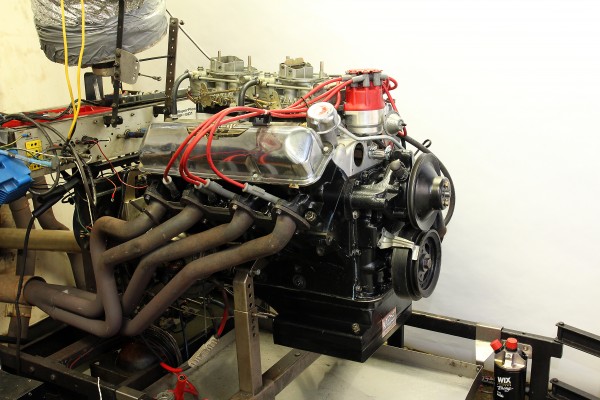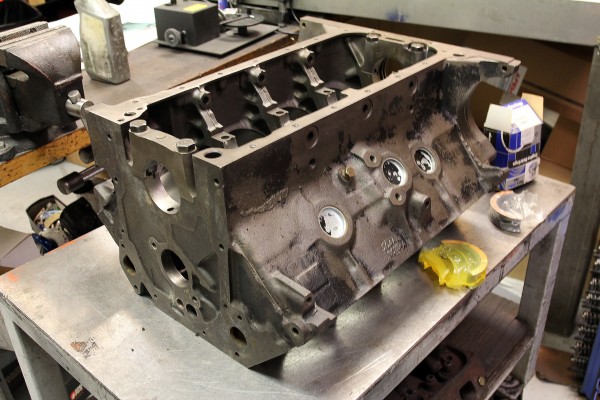The 427 is one of Ford’s most successful and iconic engines. With its 4.630-inch bore spacing and characteristic deep skirted block, the 427 slots right into Ford’s FE family of engines. But unlike its brothers, this powerplant was designed specifically for racing.
When it was first introduced in 1963, the 427 took the racing world with a bang. That first year, Ford won 23 races in NASCAR — including the Daytona 500 — with the brand-new engine. That was four better than any other manufacturer with their established engines.
Unfortunately, a serious weakness in the 427’s design was discovered fairly quickly. The block routed the oil first to the camshaft before it eventually made its way to lubricate the crank journals. During extended high-rpm operation, the lack of priority oiling to the crank would sometimes lead to a spun bearing.
Obviously, this was no good for NASCAR competition, which is all about pushing an engine to its limits for several hundred miles at a stretch. So Ford updated the original 427, the “top oiler,” to the side oiler in 1965. The side oiler prioritizes oil supply to the crankshaft first before feeding the cam and valvetrain, and that solved the 427’s issues for NASCAR racing. The side oiler is easy enough to identify because it has a hump in the block casting for the oil gallery on the driver’s side running lengthwise just above the pan rail.
Still, the 427 top oiler isn’t a bad design.
If you aren’t planning on spending a few hours making laps at Daytona, the top oiler is actually an excellent engine. Plus, if you are trying to source one they can often be had cheaper than the more famous side oiler.
Recently, we spent some time at KT Engine Development in Concord, NC, as they restored and upgraded a top oiler 427 that will be going into a classic 1964 Ford Galaxie. The owner — like most of us — wanted a bit more power, but he also wasn’t willing to sacrifice the bone-stock look that went with the rest of the car.
So KT Engines set about stuffing an absolutely ridiculous amount of inches into the block without changing anything on the outside of the engine. What they wound up with is a 427 with an astounding 498 cubic inches of displacement that is capable of gobs of torque and very respectable horsepower — all without a single exterior clue that this is anything but a tame stock rebuild. Even with the stock iron cylinder heads and dual OEM four-barrel carbs, this beast produces an astounding 500-plus ft.-lbs. of torque all the way up to 5,000 rpm and hits its peak 471.9 horsepower at 5,300 rpm. And while the less informed may poo poo the top oiler for its more famous side-oiling brother, this engine package will produce reliable performance in a street machine for years before needing a rebuild.
To see how the 498-cubic-inch top oiler came together, browse the slideshow at the top of this post.
























You can drill out the plug in the front of the lifter gallery and run a hydraulic cam, I have done it
No you can’t on a non service block because there are no oil galleys even drilled for hydraulic lifters
Correct. No galleys. But the top oilers did quite well with the lifter galleys blocked using the high riser induction in 1964. Cross bolting the main caps were the biggest improvement. The FE oiling system is the same as the SBC. The main reason for the change was to prevent pressure loss of it kicked a lifter out. It was part of the LeMans development program to prevent a gotcha. Center Oilers are still good blocks today as long as the lifter feeds are restricted or as my car has, blocked with a solid cam.
Take care Dave, I need to get those C4 heads finished and get them from you. I wish I had used 11/32 intake valves darn. Let me know when they’re done.
I meant to say the 427 CO engines never had lifter galleys until 1968 when the were hybrid SO with lifter galleys. But the 427 HRs LEd and 406 engines did fine just limited to solid cams. The HRs are still competitive in SS.
Sorry to bother you Dave, did someone borrow my heads? I’m really depressed that they got lost or broke. I did a lot to try to get the intakes to flow. If you have any ideas please let me know. Would someone really steal them. I don’t blame you at all, you are really busy and hate it that any work you did is gone. Any idea at all. I love me FEs. Take care and fair winds.
I have one in my 63 Galaxie. I gained 85HP by using 2 1/8 inch headers with 4″ collectors!
DESPITE WHAT ford SAID IN ITS ADVERTISING THE 427 ALLREADY HAD
500 HP OFF THE SHOWROOM FLOOR.THE PROBLEM WITH THE ORIGINAL 427 WAS ITS LACK OF METAL BETWEEN THE CYLINDERS THAT SAW THE PISTON AND ROD EXIT THROUGH THE CYLINDER WALL. THIS WAS CHANGED WITH THE SIDE OILER ALONG WITH OTHER THINGS.SO THE SIDE OILER IS THE BETTER ENGING BECAUSE IT HAS MORE METAL IN THE BLOCK.
1. This block clearly has the bosses (and they are drilled) for installing cross bolts on the #’s 2,3 &4 mains. The text implies that those came later.
2. It VERY likely was REQUIRED to run the BBC size big end bearings so as to keep the big ends of the rods from colliding with the cam.
3. Check your math ! Going from 3.78″ stroke to 4.375″ stroke is a LONG way from a full inch stroker !!
4. I have seen the oiling problems in top oilers solved by drilling down (really upward) from the main saddles, past the cam bores, and clear into the oil gallery with a somewhat larger diameter drill, and then cutting a bigger groove around both sides of the cam bearing bore with a disc on a die grinder.Install the cam bearings so that they oil upward from the bottom.
5. VERY wise move to install a PR valve at the BACK end of the main oil gallery set for the system pressure you want–and the put a much higher pressure relief spring in the oil pump just for a safety relief. This was done on the factory side oilers.
6. For God’s sake–install a larger diameter oil pump drive shaft !!!
7. If worried about not enough iron in the block, cast the water jackets full of cement up to the bottom of the freeze plug holes (prior to boring and honing).
The issue with such an enterprise is that metal in that area is quite precious, On a CO block with no lifter gallery’s even cast in, the risk to reward is not worth it. The best I would do is to put a dry sump and tank on it, at the very least an accusump and a cooler similar to the Cobra. I can see a small increase in width to the annular groove behind the cam bearings and the drill out the center galley to 7/16. The biggest I have done from the inlet to the rear of the block is 7/16 as consistently as possible and smoothly as possible, take the sharp turns out. Drilling any metal from the bottom is Russian Roulette. Unless you have good welding skills to the webs to increase the amount of metal at the web and bulkhead area. Drilling can cause a crack there and a massive hemmorage an drop in pressure. I have brazed these areas, but that is risky with 35-40,000 psi iron, it depends a lot on the granular integrity. Throwing mud at it the worse it gets.
I love my FEs , I really wish I knew where the C4AE-G heads I poured my heart into went. I am not able to port anymore. I lost most of my vision from a work accident that fractured my skull and took most or my sight and I fell and shattered my left shoulder and upper arm. If anyone knows where they are I’d just like to know. I hope whoever has them appreciates them. I don’t need them back. But I would buy them back. It just hurts to work so hard and then they vanished into thin air. I am not going to raise a stink. I’m just hurting because they meant a lot to me.
That must have been a lame cam and induction setup on that 496. Less than a hp per cube? That thing should have made 700 hp. Odd.
Late model 1963 406 fe blocks were of high nickel content iron for racing. The mains have cast bosses to accommodate drilling for cross bolting. Mine is cross bolted. The spec for building the engine and heads with 6v intake was to be in excess of 800 hp. However, due to other priorities, the project/engine went into storage for 25 years without test firing.